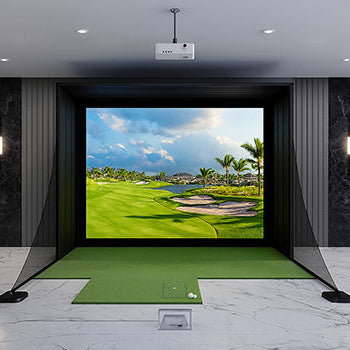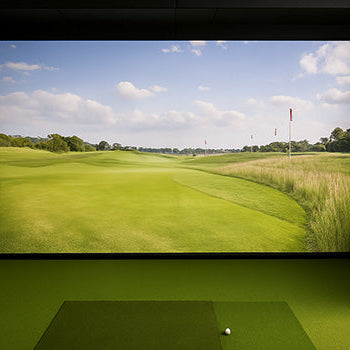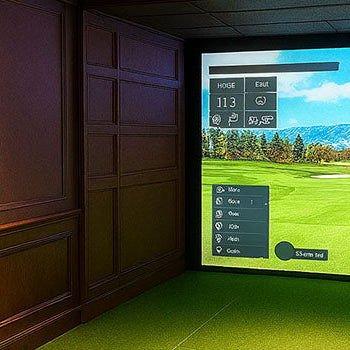Tired of chasing your ball into the woods or waiting out another rainy weekend? Here’s the truth: yes, you can get better at golf on a simulator. Today’s setups are more than just fancy arcade machines, they’re training tools used by pros and weekend warriors alike.
Think of it as a driving range with a PhD. You get data, feedback, and a year-round, weatherproof setup. Want to break 90? or 80? Let’s show you how a golf simulator can help you do just that.

The Myth of the "Simulator Swing": Fact vs. Fiction
Understanding the Differences Between Simulator and Real Golf
You’ve probably heard the phrase: “That swing only works in a simulator.” Fair. There is a difference between hitting indoors and hitting off real turf.
But let’s clear something up, modern simulators don’t lie. The data you get, clubface angle, swing path, spin rates, is the same stuff tour pros look at.
What's missing is the feel. Wind. Uneven lies. The odd squirrel running across your path. But if you treat your simulator like a real course, not a video game. You’ll see real results when you step onto grass.
How to Practice with On-Course Play in Mind
The trick? Practice with intent.
Don’t just hit balls for the sake of it. Use the course simulation mode. Set wind conditions. Picture real targets. Trees, flags, trouble on the left.
Every swing should feel like it matters, because that’s how you build habits that stick.
The #1 Advantage: Access to Actionable Data
Moving Beyond Feel: Understanding Your Numbers
Ask a mid-handicapper how far they hit their 7-iron and you’ll probably get “about 150.” But what does “about” mean?
With a simulator, there’s no guesswork. You see your carry distance, ball speed, spin rate, launch angle, instantly. And once you start seeing patterns, things click fast.
Instead of going by feel, you're going by facts. That’s the difference between “pretty good” and progress.
Identifying Strengths and Weaknesses with Precision
Let’s say you're slicing your driver. On the range, you might just try to swing harder or aim left. On a simulator? You’ll know your face is open, your path is out-to-in, and you’re losing ball speed.
It’s like having a coach whispering into your ear after every shot.
Want to know why your wedges come up short? The simulator will show you. And once you know, you can fix it.
How to Use Data to Structure Your Practice
This is where most golfers drop the ball, literally. You’ve got all the data, but no plan.
So build one. If your clubface is consistently open by 3°, work on squaring it up. If your spin is too low on mid-irons, adjust your attack angle.
Use the numbers as a roadmap, not just fun facts to scroll through.

Structured Practice: The Key to Improvement
Gapping Your Distances: Know Exactly How Far You Hit Each Club
Ever flown a green with a pitching wedge and thought, “That felt too good”?
That’s where gapping comes in. Gapping is knowing your carry distance for each club, not your best shot, but your average.
Spend one session hitting 10 shots per club. Chart your carry and rollout. Once you know your numbers, you’ll stop second-guessing and start aiming smarter.
Shot Shaping Drills: Learning to Draw and Fade on Command
Simulator time is the perfect time to learn shot shapes. Pick a target line and try to draw the ball five times in a row. Then fade it. Then hit it straight.
You’ll fail at first, and that’s good. Mistakes in here cost you nothing but help you build skills you’ll need on the course.
Use the data to adjust path and face. Soon, you won’t just hit shots, you’ll shape them on demand.
Performance Games and Skills Challenges
Let’s be honest: practice can get boring. That’s why most simulators come with games and skills challenges.
Closest to the pin, target zones, timed challenges, they add pressure and fun at the same time. Play against friends or challenge yourself.
It’s not just fun, it’s functional. These mini-games mimic real on-course decisions, and that’s where true improvement lives.
Taking Your Simulator Gains to the Golf Course
Building Trust in Your New Swing and Distances
The first time you take your new swing to the course, you’ll doubt it. That’s natural.
But remind yourself: you’ve put in the work. If your 8-iron flies 135 in the simulator, it’ll fly 135 outside, unless you panic and decelerate.
Trust the process. Trust the reps. That’s how practice becomes performance.
Focusing on Pre-Shot Routine and Target Awareness
Don’t skip the mental game during simulator practice. Visualise your target. Walk into every shot with purpose. Breathe, set up, swing.
The pre-shot routine is your anchor, and it should be the same indoors or out.
The more consistent your setup is, the less room nerves have to creep in on the first tee.
The Areas You Still Need to Practice on a Real Course (e.g., Putting, Bunker Play)
Now, let’s be honest: simulators are amazing, but they can’t do it all.
Putting, bunker play, and uneven lies still need real-world reps. You can’t feel the softness of sand on a screen. You can’t gauge grain or slope indoors.
So mix it up. Use your simulator for long game, shaping, and stat tracking. Then spend a session a week on the chipping green or in the bunker. That’s how you build a complete game.

Creating an Effective Game Improvement Plan with Your Simulator
Setting Goals and Tracking Progress
Improving your golf game without goals is like driving without a destination.
Start simple: “Hit 7/10 drives in the fairway.” “Add 5mph to swing speed.” “Reduce dispersion with wedges.”
Track your progress week by week, using the simulator’s built-in tools. The numbers won’t lie, and seeing growth will keep you motivated.
A Sample Weekly Practice Schedule
Here’s a real-life golf simulator practice routine that fits most busy schedules:
Monday (30 min): Gapping session, carry distances and dispersion
Wednesday (1 hour): Shot shaping + performance games
Friday (1 hour): Virtual 9-hole course with full routine
Sunday (30 min): Review stats, adjust goals, focus on weaknesses
Even just 2–3 quality sessions per week can lead to real, lasting improvement. Focus on variety, structure, and intention.
Final Thoughts
So, can you get better at golf on a simulator? 100%, yes.
It’s not magic, it’s muscle memory, made smarter. With data, structure, and a few hours a week, you’ll hit more greens, find more fairways, and show up to your weekend rounds feeling ready.
Combine your one hour golf simulator practice routine with real-world short game reps, and your scorecard will show the difference.
The best part? You can do it all without ever leaving your garage.









